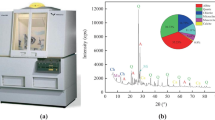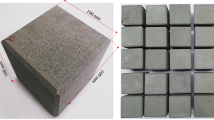Abstract
Through the uniaxial compression tests of sandstone, the crack closure effect and the relationship between the crack parameters and the height to diameter ratio (H/D) were analyzed. Then, a nonlinear model for characterizing energy dissipation based on the crack closure effect was established. The results show that the peak strength and peak axial strain of sandstone decrease gradually with the increase of H/D, but the elastic modulus has a small change. The maximum crack axial closure strain and crack axial closure stress of sandstone increase with the H/D. While the peak crack axial strain and axial crack initiation stress decrease. The dissipative energy firstly increases with the axial stress, and the increase rate decreases gradually. Then, the dissipative energy nearly remains as a constant. The axial crack closure model was established to describe the crack closure effect of sandstone, and the equivalent elastic modulus of crack closure of sandstone calculated by axial crack closure model decreases nonlinearly with the H/D. A rock energy dissipation model based on crack closure under uniaxial compression was established. The experimental results agree well with the theoretical values, which indicates that the proposed model can describe the energy dissipation of rocks under uniaxial compression. The research conclusion provides a theoretical reference for the stability evaluation of underground rock masses with different sizes.










Similar content being viewed by others
References
Bieniawski ZT (1967) Mechanism of brittle fracture of rock: part I—theory of the fracture process. Int J Rock Mech Min Sci Geomech Abstr 4:395–430. https://doi.org/10.1016/0148-9062(67)90030-7
Freed AD (1995) Natural strain. J Eng Mater Tech 117:379–385. https://doi.org/10.1115/1.2804729
Hencky H (1931) The law of elasticity for isotropic and quasi-isotropic substances by finite deformations. J Rheol 2:169–176. https://doi.org/10.1122/1.2116361
Huang D, Li Y (2014) Conversion of strain energy in triaxial unloading tests on marble. Int J Rock Mech Min Sci 65:160–168. https://doi.org/10.1016/j.ijrmms.2013.12.001
Ji P, Zhang X, Zhang Q (2018) A new method to model the non-linear crack closure behavior of rocks under uniaxial compression. Int J Rock Mech Min Sci 112:171–183. https://doi.org/10.1016/j.ijrmms.2018.10.015
Li D, Sun Z, Xie T, Ranjith PG (2017) Energy evolution characteristics of hard rock during triaxial failure with different loading and unloading paths. Eng Geol 228:270–281. https://doi.org/10.1016/j.enggeo.2017.08.006
Liu H, Rutqvist J, Berryman JG (2009) On the relationship between stress and elastic strain for porous and fractured rock. Int J Rock Mech Min Sci 46:289–296. https://doi.org/10.1016/j.ijrmms.2008.04.005
Martin CD, Chandler NA (1994) The progressive fracture of Lac Du Bonnet granite. Int J Rock Mech Min Sci Geomech Abstr 31:643–659. https://doi.org/10.1016/0148-9062(94)90005-1
Peng J, Rong G, Cai M, Zhou CB (2015) A model for characterizing crack closure effect of rocks. Eng Geol 189:48–57. https://doi.org/10.1016/j.enggeo.2015.02.004
Wang P, Xu J, Fang X, Wang PX (2017) Energy dissipation and damage evolution analyses for the dynamic compression failure process of red-sandstone after freeze-thaw cycles. Eng Geol 221:104–113. https://doi.org/10.1016/j.enggeo.2017.02.025
Wang H, Yi S, Sharma MM (2018) A computationally efficient approach to modeling contact problems and fracture closure using superposition method. Theor Appl Fract Mec 93:276–287. https://doi.org/10.1016/j.tafmec.2017.09.009
Wang D, He S, Tannant DD (2019) A strain based method for determining the crack closure and initiation stress in compression tests. KSCE J Civ Eng 23(4):1819–1828. https://doi.org/10.1007/s12205-019-0563-7
Xie HP, Li LY, Peng RD, Ju Y (2009) Energy analysis and criteria for structural failure of rocks. J Rock Mech Geotech Eng 1:11–20. https://doi.org/10.3724/SP.J.1235.2009.00011
Yang S, Xu W, Su C (2006) Study on the deformation failure and energy properties of rock specimen in uniaxial compression. Acta Mech Solida Sin 27: 213–216. https://doi.org/10.19636/j.cnki.cjsm42-1250/o3.2006.02.017 (in Chinese)
Zhang Z, Gao F (2012) Research on nonlinear characteristics of rock energy evolution under uniaxial compression. Chin J Rock Mech Eng 31:1198–1207. https://doi.org/10.3969/j.issn.1000-6915.2012.06.015(in Chinese)
Zhang Z, Gao F (2015) Experimental investigation on the energy evolution of dry and water-saturated red sandstones. Int J Min Sci Tech 25:383–388. https://doi.org/10.1016/j.ijmst.2015.03.009
Acknowledgements
This study was funded by National Natural Science Foundation of China (Grant NO. 51904092), the research fund of Henan Key Laboratory for Green and Efficient Mining & Comprehensive Utilization of Mineral Resources, Henan Polytechnic University (Grant No. KCF201803) and Scientific and Technological Research Project of Henan Province (Grant No. 182102310020).
Author information
Authors and Affiliations
Corresponding author
Additional information
Publisher's Note
Springer Nature remains neutral with regard to jurisdictional claims in published maps and institutional affiliations.
Rights and permissions
About this article
Cite this article
Chen, Y., Guo, B. Crack Closure Effect and Energy Dissipation Model for Rocks under Uniaxial Compression. Geotech Geol Eng 38, 621–629 (2020). https://doi.org/10.1007/s10706-019-01051-4
Received:
Accepted:
Published:
Issue Date:
DOI: https://doi.org/10.1007/s10706-019-01051-4




